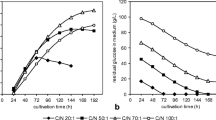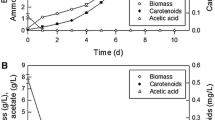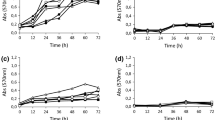Abstract
The composition of carotenoids produced byR. glutinis was observed to be dependent upon the addition of phenol into medium. A stimulatory effect of phenol on Β-carotene ofRhodotorula glutins K-501 grown on glucose was investigated. Carotenoids produced byRhodotorula glutinis K-501 were identified to torularhodin, torulene and Β-carotene, whose composition was 79.5%, 6.4% and 14.1%, respectively. The Β-carotene content increased up to 35% when phenol was added to culture media at 500 ppm. The ratio of torularhodin decreased with increasing phenol concentration, while torulene content was almost constant.
Similar content being viewed by others
References
An, G. H., Cho, M. H. and Jang, B. G., “Cultivation of the Carotenoid-Hyperproducing Mutant 2A2N of the Red YeastXanthophyllomyces dendrorhous (Phaffia rhodozyma) with Molasses,”J. Biosci. Bioeng.,92, 121 (2001).
An, G H., Schuman, D. B. and Johnson, E. A., “Isolation ofPhaffia rhodozyma Mutants with Increased Astaxanthin Content”,Appl. Environ. Microbiol,55, 116 (1989).
Bhosale, P. and Gadre, R. V., “Production of Β-Carotene by aRhodotorula glutinis Mutant in Sea Water Medium,”Biosorce Technol.,76, 53 (2001).
Boyer, R. F., “Modern Experimental Biochemistry,” The Benjamin/Cummings Publishing Company, San Francisco, USA (1993).
Costa, I., Martelli, H. L., DaSilva I. M. and Pomeroy, D., “Production of Β-Carotene by aRhodotorula Strain,”Biotechnol. Lett.,9, 373 (1987).
Edge, R, McGarvey, D. J. and Truscott, T. G, “The Carotenoids as Antioxidants - a Review,”Photochem. Photobiol,41, 189 (1997).
Feist, C. F. and Heheman, G. D., “Phenol and Benzoate Metabolism byPseudomonas putida: Regulation of Tangential Pathways“J. Bacteriol.,100, 869 (1969).
Frengova, G. I, Simova, E. D. and Beshkova, D. M., “Effect of Temperature Changes on the Production of Yeast Pigments Co-cultivated with Lacto-Acid Bacteria in Whey Ultrafiltrate,”Biotechnol. Lett.,17, 1001 (1995).
Gerster, H., “Anticarcinogenic Effect of Common Carotenoids,”Inter. J. Vit. Nutr. Res.,63, 93 (1992).
Girad, P., Falconnier, B., Bricout, J. and Vladesc, B., “Β-Carotene Producing Mutants ofPhaffia rhodozyma,”Appl. Microbiol. Biotechnol.,41, 183 (1994).
Katayama-Hirayama, K., Tobita, S. and Hirayama, K., “Metabolic Pathway of Phenol inRhodotorula rubra,”J. Gen. Appl. Microbiol.,37, 379 (1991a).
Katayama-Hirayama, K., Tobita, S. and Hirayama, K., “Degradation of Phenol by YeastRhodotorula,”J. Gen. Appl. Microbiol.,37, 147 (1991b).
Katayama-Hirayama, K., Tobita, S. and Hirayama, K., “Biodegradation of Phenol and Monochlorophenols by YeastRhodotorula glutinis,”Water. Sci. Tech.,30, 59 (1994).
Kim, E. Y, Park, P. K. and Chae, H. J., “Optimization of Culture Conditions for Extracellular Lipid Production fromRhodotorula glutinis,”Korean J. Biotechnol. Bioeng.,13, 58 (1997).
Krebs, H. A., Wiggins, D. and Stubbs, M., “Studies on the Mechanism of the Antifungal Action of Benzoate,”Biochem. J.,214, 657 (1983).
Meyer, P. S. and Du Preez, J. C., “Photo-regulated Astaxanthin Production byPhaffia rhodozyma Mutants,”System, Appl. Microbiol.,17, 24 (1994).
Miller, G. L., “Use of Dinitrosalicylic Acid Reagent for Determination of Reducing Sugar,”Anal. Chem.,31, 426 (1959).
Nam, H. S., Cho, S. Y. and Rhee, J. S., “High-performance Liquid Chromatographic Analysis of Major Carotenoids fromRhodotorula glutinis,”J. Chromato.,448, 445 (1988).
Nakayama, T, Mackinney, G. and Phaff, H. J., “Carotenoids in Asporogenous Yeasts,”J. Microbiol. Serol,20, 217 (1954).
Nelis, H. J. and De Leenheer, A. P., “Microbial Sources of Carotenoid Pigments Used in Food and Feeds,”J. Appl. Bacteriol.,70, 181 (1991).
Nesaretnam, K., Lim, E. J., Reimann, K. and Lai, L. C, “Effect of a Carotene Concentrate on the Growth Human Breast Cancer Cells and pS2 Gene Expression,”Toxicology,151, 117 (2000).
Parajo, J. C., Santos, V. and Vazquez, M., “Optimization of Carotenoid Production byPhaffia rhodozyme Cells Grown on Xylose,”Process Biochem.,33, 181 (1998).
Park, H. J. and Chung, T. S., “Removal of Phenol from Aqueous Solution by Liquid Emulsion Membrane,”Korean J. Chem, Eng.,20, 731 (2003).
Polulyakh, O. V., Podoprigora, O. I., Eliseev, S. A., Ershov, Y V, Bykhovsk, V. Y. and Dmitrovsk, A. A., “Biosynthesis of Torulene and Torularhodin by the YeastPhaffia rhodozyma,”Prikladnaya Biokhimiya Mikrobiologiy,27, 541 (1991).
Sies, H. and Stahl, W, “Antioxidant Activity of Carotenoids,”Mol. Aspects Med.,24, 345 (1987).
Schroeder, W A. and Johnson, E. A., “Antioxidant Role of Carotenoids inPhaffia rhodozyma”,J. Gen. Microbiol.,139, 907 (1993).
Schroeder, W A. and Johnson, E. A., “Carotenoids ProtectPhaffia rhodozyma Against Singlet Oxygen Damage”,J. Ind. Microbiol,14, 502 (1995).
Simpson, K. L., Nakayama, T. O. M. and Chichester, C. O., “Biosynthesis of Yeast Carotenoids,”J. Bact,88, 1688 (1964).
Walker, N., “Metabolism of Chlorophenols by Rhodotorula glutinis7”Soil Biol. Biochem.,5, 525 (1973).
Xiaoli, Y, Huixiang, S. and Dahui, W, “Photoelectrocatalytic Degradation of Phenol using a TiO2/Ni Thin-film Electrode,”Korean J. Chem, Eng.,20, 679 (2003).
Young, A. J., Lowe, G. M. and Vlismas, K., “Carotenoids as Prooxidants?,”Mol. Aspects Med.,24, 363 (2003).
Young, A. and Britton, G., “Carotenoids in Photosynthesis,” Chapman & Hall, London, UK (1993).
Author information
Authors and Affiliations
Corresponding author
Rights and permissions
About this article
Cite this article
Kim, B.K., Park, P.K., Chae, H.J. et al. Effect of phenol on Β-carotene content in total carotenoids production in cultivation ofRhodotorula glutinis . Korean J. Chem. Eng. 21, 689–692 (2004). https://doi.org/10.1007/BF02705506
Received:
Accepted:
Issue Date:
DOI: https://doi.org/10.1007/BF02705506




